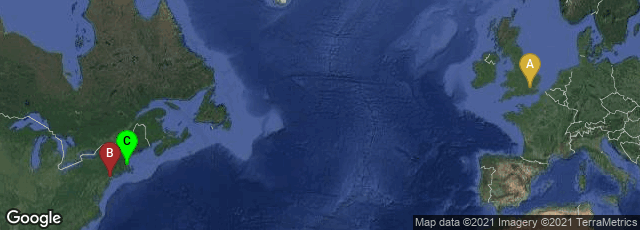
A: London, England, United Kingdom, B: Manhattan, New York, New York, United States, C: Boston, Massachusetts, United States
In November 1833 a stereotype reprint of The Penny Magazine began publication in New York by William Jackson. It was also distributed in Boston by Munroe & Francis. Printed from stereotype plates, the first American edition was essentially identical to the English version except that, printed on American paper which was typically inferior to the English paper of this period, the paper used for the American version has a tendency to brown. On the verso of the title page of volume 1 the publisher issued a Preface to the American Edition. Following the writings of English publisher of The Penny Magazine Charles Knight, who was virtually an evangelist for the new technology, at the end of his preface Jackson credits the new printing machines for their essential role in producing his edition:
"The unparalleled sale of the "Penny Magazine" in the United Kingdom, as well as the highly valuable, interesting, and useful information contained in the work, induced the Proprietor of this edition to make arrangements with the Publisher in London, for a new and complete set of Stereotype Plates to be cast from the original edition. These plates have nearly all arrived, and the Second Volume is now in the course of publication.
"This undertaking is attended with the same difficulties and expenses, so fully pointed out in the following preface to the English edition, and to which we would refer our numerous readers. It has also to contend with several imitations compiled principally from its pages, none of which, however, have yet equalled it in the extent of matter, or the beauty and number of the engravings. The "Penny Magazine" is sold either in Numbers, at Two Cents each, or in Monthly Parts, to which are added Supplements, at Twelve and a Half Cents: the purchaser thus receives Sixty-four Numbers for One Dollar and a Half; while the most successful of the works of similar nature, published in the United States, furnishes only Twenty-six numbers (containing less matter in each) for a subscription of One Dollar.
"Without the aid of Machinery, — which has arrived in this country to great perfection, especially in the art of printing, — the "Penny Magazine" could not be published at its present price; and even with this aid, it must have a large circulation, to cover the heavy charges attending its progress through the press and distribution throughout this extensive country."
According to "Stephen D. Tucker's History of R. Hoe & Company, 1834-1885. Edited with an Introduction by Rollo G. Silver", Proc. Am. Ant. Soc., 82 (1973) p. 359 for the American reissue of The Penny Magazine Jackson employed "two large Cylinder Perfecting Presses (Cowper & Applegath's system)" which were " built and were for a time in operation at the corner of John and Gold Streets" in New York.